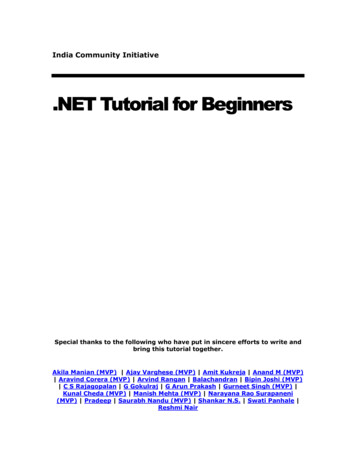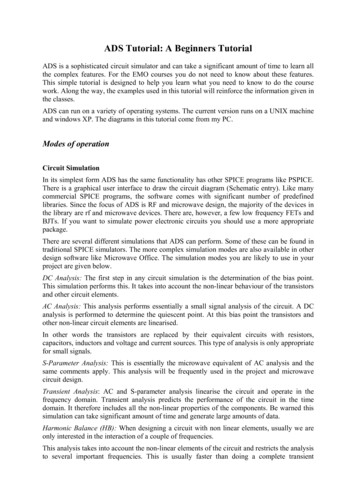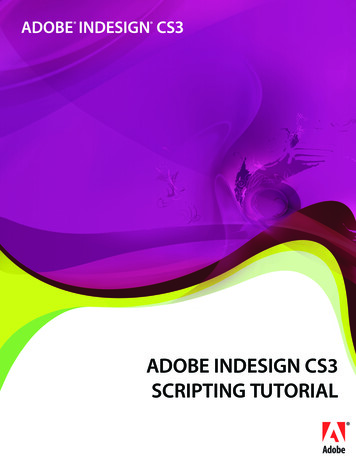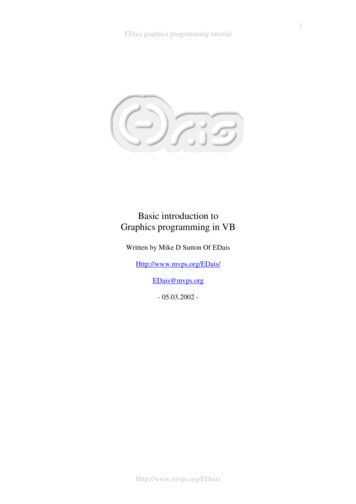
Transcription
India Community Initiative.NET Tutorial for BeginnersSpecial thanks to the following who have put in sincere efforts to write andbring this tutorial together.Akila Manian (MVP) Ajay Varghese (MVP) Amit Kukreja Anand M (MVP) Aravind Corera (MVP) Arvind Rangan Balachandran Bipin Joshi (MVP) C S Rajagopalan G Gokulraj G Arun Prakash Gurneet Singh (MVP) Kunal Cheda (MVP) Manish Mehta (MVP) Narayana Rao Surapaneni(MVP) Pradeep Saurabh Nandu (MVP) Shankar N.S. Swati Panhale Reshmi Nair
Content1. Getting Ready . 41.1 Tracing the .NET History.41.2 Flavors of .NET.51.3 Features of .NET. 101.4 Installing the .NET Framework SDK. 122. Introduction to the .NET Initiative and the .NET Platform . 152.1 Understanding the Existing Development Scenario. 152.2 Challenges faced by developers. 182.3 NET Philosophy / Where does .NET fit in? . 212.4 Understanding the .NET Platform and its layers . 252.5 Understanding the various components of the .NET Platform and the functionsperformed by them . 302.6 Structure of a .NET Application. 373. Code Management. 433.1 Introduction. 433.2 First VB.NET / C# program . 453.3 JIT (Just–in-Time Compiler) & Debugging . 513.4 Managed Vs. Unmanaged Methods/Transitions . 563.5 Summary . 614. Language Features of C# . 624.1 History of C# . 624.2 Language Fundamentals in C# . 634.3 Control Statements. 744.4 Arrays . 835. Language Features of VB.NET . 885.1 History of VB.NET . 885.2 Language Fundamentals in VB.NET . 895.3 Features of VB.NET . 995.4 Control Statements. 1075.5 Arrays . 1156. Object Oriented Programming Concepts . 1226.1 Concept of Procedural Programming. 1236.2 Object Oriented Programming . 1266.3 Classes. 1276.4 Encapsulation. 1276.5 Inheritance . 1286.6 Polymorphism . 1296.7 Understanding CSharp and VB.NET as Object Oriented Programming languages. 1326.8 Polymorphism . 1496.9 Abstract Classes (Virtual Class) . 1576.10 Interfaces . 1616.11 Delegates and Events . 1636.12 Structures. 168
6.13 Sample Application: OOPS . 1707. Error and Exception Handling. 1727.1 Need for Error Handling. 1727.2 Old-school unstructured exception handling in VB 6.0 and its disadvantages. 1737.3 Structured Exception Handling in C#/VB.NET . 1747.4 System.Exception: The mother of all exceptions . 1777.5 Handling exceptions that are not System.Exception compliant. 190Catch. 1917.6 Understanding Application exceptions (user-defined or custom exceptions). 1917.7 Nesting try/catch/finally blocks and re-throwing exceptions . 1987.8 Parting thoughts . 2118. Assemblies and Application Domains . 2128.1 Introduction. 2128.2 Assembly Types. 2128.3 Private Assemblies. 2178.4 Shared Assemblies. 2178.5 Application Domains. 2188.6 Conclusion . 223
1. Getting ReadySection Owner: Ajay Varghese (MVP)Content Contributors: Bipin Joshi (MVP)Welcome friends to the exciting journey of Microsoft .NET. If you are looking forinformation about what .NET is all about, what it can do for you or how it can help youand your customers, you have come to the right place. This section is intended to tell youabout these and many more things. After covering this section you will be ready to delveinto details of .NET.The section is divided into following sub-sections:1) Tracing the .NET History2) Flavors of .NET3) Features of .NET4) Installing .NET Framework SDKThe first sub-section will introduce you with how .NET evolved and the path of .NETsince its Beta releases.The second sub-section will introduce you with various flavors of.NET and theirrespective SDKs. It also gives overview of Visual Studio.NET – an excellent IDE fordeveloping .NET applications.It is necessary to understand the features of .NET that make it robust, programmerfriendly, powerful and flexible. The third sub-section is intended just for that. It givesoverview of technical features that make .NET shine over traditional programmingenvironments.The final sub-section tells you how to install .NET framework SDK, what are the systemrequirements and related topics.1.1 Tracing the .NET HistorySometime in the July 2000, Microsoft announced a whole new software developmentframework for Windows called .NET in the Professional Developer Conference (PDC).Microsoft also released PDC version of the software for the developers to test. Afterinitial testing and feedback Beta 1 of .NET was announced. Beta 1 of the .NET itself gotlot of attention from the developer community. When Microsoft announced Beta 2, itincorporated many changes suggested by the community and internals into the software.The overall ‘Beta’ phase lasted for more than 1 ½ years. Finally, in March 2002Microsoft released final version of the .NET framework.
One thing to be noted here is the change in approach of Microsoft while releasing thisnew platform. Unlike other software where generally only a handful people are involvedin beta testing, .NET was thrown open to community for testing in it’s every pre-releaseversion. This is one of the reasons why it created so many waves of excitement within thecommunity and industry as well.Microsoft has put in great efforts in this new platform. In fact Microsoft says that itsfuture depends on success of .NET. The development of .NET is such an important eventthat Microsoft considers it equivalent to transition from DOS to Windows. All the futuredevelopment – including new and version upgrades of existing products – will revolvearound .NET. So, if you want to be at the forefront of Microsoft Technologies, youshould be knowing .NET!Now, that we know about brief history of .NET let us see what .NET has to offer.1.2 Flavors of .NETContrary to general belief .NET is not a single technology. Rather it is a set oftechnologies that work together seamlessly to solve your business problems. Thefollowing sections will give you insight into various flavors and tools of .NET and whatkind of applications you can develop. What type of applications can I develop?When you hear the name .NET, it gives a feeling that it is something to do onlywith internet or networked applications. Even though it is true that .NET providessolid foundation for developing such applications it is possible to create manyother types of applications. Following list will give you an idea about varioustypes of application that we can develop on .NET.1. ASP.NET Web applications: These include dynamic and data driven browserbased applications.2. Windows Form based applications: These refer to traditional rich clientapplications.3. Console applications: These refer to traditional DOS kind of applications likebatch scripts.4. Component Libraries: This refers to components that typically encapsulatesome business logic.5. Windows Custom Controls: As with traditional ActiveX controls, you candevelop your own windows controls.6. Web Custom Controls: The concept of custom controls can be extended toweb applications allowing code reuse and modularization.7. Web services: They are “web callable” functionality available via industrystandards like HTTP, XML and SOAP.
8. Windows Services: They refer to applications that run as services in thebackground. They can be configured to start automatically when the systemboots up.As you can clearly see, .NET is not just for creating web application but foralmost all kinds of applications that you find under Windows. .NET Framework SDKYou can develop such varied types of applications. That’s fine. But how? As withmost of the programming languages, .NET has a complete Software DevelopmentKit (SDK) - more commonly referred to as .NET Framework SDK - thatprovides classes, interfaces and language compilers necessary to program for.NET. Additionally it contains excellent documentation and Quick Start tutorialsthat help you learn .NET technologies with ease. Good news is that - .NETFramework SDK is available FREE of cost. You can download it from the MSDNweb site. This means that if you have machine with .NET Framework installedand a text editor such as Notepad then you can start developing for .NET rightnow!You can download entire .NET Framework SDK (approx 131 Mb) from MSDNweb site url /downloads/sample.asp?url /msdn-files/027/000/976/msdncompositedoc.xml Development ToolsIf you are developing applications that require speedy delivery to your customersand features like integration with some version control software then simpleNotepad may not serve your purpose. In such cases you require some IntegratedDevelopment Environment (IDE) that allows for Rapid Action Development(RAD). The new Visual Studio.NET is such an IDE. VS.NET is a powerful andflexible IDE that makes developing .NET applications a breeze. Some of thefeatures of VS.NET that make you more productive are:-Drag and Drop designIntelliSense featuresSyntax highlighting and auto-syntax checkingExcellent debugging toolsIntegration with version control software such as Visual Source Safe (VSS)Easy project managementNote that when you install Visual Studio.NET, .NET Framework is automaticallyinstalled on the machine.
Visual Studio.NET EditionsVisual Studio.NET comes in different editions. You can select edition appropriatefor the kind of development you are doing. Following editions of VS.NET areavailable:-ProfessionalEnterprise DeveloperEnterprise ArchitectVisual Studio .NET Professional edition offers a development tool forcreating various types of applications mentioned previously. Developers canuse Professional edition to build Internet and Develop applications quicklyand create solutions that span any device and integrate with any platform.Visual Studio .NET Enterprise Developer (VSED) edition contains all thefeatures of Professional edition plus has additional capabilities for enterprisedevelopment. The features include things such as a collaborative teamdevelopment, Third party tool integration for building XML Web services andbuilt-in project templates with architectural guidelines and spanningcomprehensive project life-cycle.Visual Studio .NET Enterprise Architect (VSEA) edition contains all thefeatures of Visual Studio .NET Enterprise Developer edition and additionallyincludes capabilities for designing, specifying, and communicating applicationarchitecture and functionality. The additional features include Visual designerfor XML Web services, Unified Modeling Language (UML) support andenterprise templates for development guidelines and policies.A complete comparison of these editions can be found ing.aspIn addition to these editions, special language specific editions are available. Theyare:-Visual Basic.NET Standard EditionVisual C# Standard EditionVisual C .NET Standard (soon to be released)These editions are primarily for hobbyist, student, or beginner who wants totry their hands on basic language features.
A complete comparison of these standard editions with professional edition ofVS.NET can be found choosing.asp .NET RedistributableIn order to run application developed using .NET Framework the machine musthave certain ‘runtime’ files installed. They are collectively called as .NETredistributable. This is analogous to traditional Visual Basic applications thatrequired Visual Basic runtime installed on target computers. .NET redistributableprovides one redistributable installer that contains the common language runtime(more on that later) and Microsoft .NET Framework components that arenecessary to run .NET Framework applications. The redistributable is available asa stand-alone executable and can be installed manually or as a part of yourapplication setup.You can download .NET redistributable url /downloads/sample.asp?url /msdn-files/027/001/829/msdncompositedoc.xmlMore technical information about .NET redistributable can be found l /library/enus/dnnetdep/html/dotnetfxref.aspNote that if you have installed .NET Framework SDK, there is no need ofinstalling redistributable separately. Also, note that there is difference between.NET Framework SDK and .NET redistributable in terms of purpose and toolsand documentation supplied. .NET Framework SDK is intended to ‘develop’applications where as .NET redistributable is intended to ‘run’ .NET applications. .NET and mobile developmentNow days the use of mobile and wireless devices is ever increasing. PDAs,mobile phones, Smartphones, handheld PCs and HTML pagers are becomingcommon. As compared to full blown desktop computers, Mobile devices aregenerally resource-constrained. There are limitations on what they can displayand in which form. For example you can easily display graphical menus indesktop applications but the same may not be possible for cell phones.Today there are many vendors making CPUs and development tools for mobiledevices. However, their standards are much varying. For example devices runningWindows CE will have different tools and standards of development than PalmOS. Also, programming model for such devices is an issue of debate. Forexample, Wireless Application Protocol (WAP) was considered a ‘standard’ formobile devices but it introduced disadvantages of its own such as requirement of
continuous connectivity, lack in rich user interface and failure to utilize client –side resources effectively.Mobile devices can be broadly divided into two categories:1) Mobile Devices that have certain client-side resources like PDAs,Smartphones and Handheld PCs. They can run stand-alone application withrich user interface.2) Mobile Devices that lack even these client-side resources such as mobilephones. They can not run stand alone applications having rich and moreinteractive user interface.In order to encompass all possible devices from above categories Microsoft hasdeveloped two distinct technologies namely:-Microsoft .NET Compact Framework (.NET CF)Microsoft Mobile Internet Toolkit (MMIT)oMicrosoft .NET Compact Framework.NET compact framework is a sub set of entire .NET framework and istargeted at mobile devices having some client side resources. It providessupport for managed code and XML Web services. Currently, .NETCompact Framework is in Beta 1 and is available on devices running theWindows CE or Windows CE .NET operating systems. However,Microsoft has promised support for other platforms in the future. As ofnow the framework supports Visual Basic.NET and C# as developmentlanguages out of the box. Support for other languages is planned in nearfuture.Microsoft is creating a set of extensions for Visual Studio .NET calledSmart Device Extensions that will allow Visual Studio .NET developers toprogram for .NET Compact Framework. This means that developersfamiliar with Visual Studio.NET can start developing for mobile devicesalmost instantly.More information about .NET Compact Framework can be obtained .aspoMicrosoft Mobile Internet ToolkitMicrosoft Mobile Internet Toolkit (MMIT) is designed to develop serverside applications for mobile devices such as cell phones, PDAs, andpagers. It is different than .NET compact Framework in that it is a serverside technology. It is ideal for devices that can not run stand aloneapplications.MMIT mainly uses ASP.NET as a technology for delivering markup to awide variety of mobile devices. As we know that each mobile device has
its own set of underlying standards and markup. MMIT shields thesedetails from the developer and allows ‘uniform code’ for any targetdevice. Based on the capabilities of target device the output is rendered.More information about MMIT can be obtained fault.asp1.3 Features of .NETNow that we know some basics of .NET, let us see what makes .NET a wonderfulplatform for developing modern applications. Rich Functionality out of the box.NET framework provides a rich set of functionality out of the box. It containshundreds of classes that provide variety of functionality ready to use in yourapplications. This means that as a developer you need not go into low level detailsof many operations such as file IO, network communication and so on. Easy development of web applicationsASP.NET is a technology available on .NET platform for developing dynamicand data driven web applications. ASP.NET provides an event drivenprogramming model (similar to Visual Basic 6 that simplify development of webpages (now called as web forms) with complex user interface. ASP.NET servercontrols provide advanced user interface elements (like calendar and grids) thatsave lot of coding from programmer’s side. OOPs SupportThe advantages of Object Oriented programming are well known. .NET providesa fully object oriented environment. The philosophy of .NET is – “Object ismother of all.” Languages like Visual Basic.NET now support many of the OOfeatures that were lacking traditionally. Even primitive types like integer andcharacters can be treated as objects – something not available even in OOlanguages like C . Multi-Language SupportGenerally enterprises have varying skill sets. For example, a company might havepeople with skills in Visual Basic, C , and Java etc. It is an experience thatwhenever a new language or environment is invented existing skills are outdated.This naturally increases cost of training and learning curve. .NET providessomething attractive in this area. It supports multiple languages. This means thatif you have skills in C , you need not throw them but just mould them to suit.NET environment. Currently four languages are available right out of the boxnamely – Visual Basic.NET, C# (pronounced as C-sharp), Jscript.NET and
Managed C (a dialect of Visual C ). There are many vendors that areworking on developing language compilers for other languages (20 languagecompilers are already available). The beauty of multi language support lies in thefact that even though the syntax of each language is different, the basiccapabilities of each language remain at par with one another. Multi-Device SupportModern lift style is increasingly embracing mobile and wireless devices such asPDAs, mobiles and handheld PCs. . . .NET provides promising platform forprogramming such devices. .NET Compact Framework and Mobile InternetToolkit are step ahead in this direction. Automatic memory managementWhile developing applications developers had to develop an eye on systemresources like memory. Memory leaks were major reason in failure ofapplications. .NET takes this worry away from developer by handling memory onits own. The garbage collector takes care of freeing unused objects at appropriateintervals. Compatibility with COM and COM Before the introduction of .NET, COM was the de-facto standard forcomponentized software development. Companies have invested lot of money andefforts in developing COM components and controls. The good news is – you canstill use COM components and ActiveX controls under .NET. This allows you touse your existing investment in .NET applications. .NET still relies on COM forfeatures like transaction management and object pooling. In fact it providesenhanced declarative support for configuring COM application right from yoursource code. Your COM knowledge still remains as a valuable asset. No more DLL HellIf you have worked with COM components, you probably are aware of “DLLhell”. DLL conflicts are a common fact in COM world. The main reason behindthis was the philosophy of COM – “one version of component across machine”.Also, COM components require registration in the system registry. .NET ends thisDLL hell by allowing applications to use their own copy of dependent DLLs.Also, .NET components do not require any kind of registration in system registry. Strong XML supportNow days it is hard to find a programmer who is unaware of XML. XML hasgained such a strong industry support that almost all the vendors have releasedsome kind of upgrades or patches to their existing software to make it “XMLcompatible”. Currently, .NET is the only platform that has built with XML rightinto the core framework. .NET tries to harness power of XML in every possibleway. In addition to providing support for manipulating and transforming XMLdocuments, .NET provides XML web services that are based on standards likeHTTP, XML and SOAP.
Ease of deployment and configurationDeploying windows applications especially that used COM components werealways been a tedious task. Since .NET does not require any registration as such,much of the deployment is simplified. This makes XCOPY deployment viable.Configuration is another area where .NET – especially ASP.NET – shines overtraditional languages. The configuration is done via special files having specialXML vocabulary. Since, most of the configuration is done via configuration files,there is no need to sit in front of actual machine and configure the applicationmanually. This is more important for web applications; simply FTPing newconfiguration file makes necessary changes. SecurityWindows platform was always criticized for poor security mechanisms. Microsofthas taken great efforts to make .NET platform safe and secure for enterpriseapplications. Features such as type safety, code access security and role basedauthentication make overall application more robust and secure.1.4 Installing the .NET Framework SDKNow that you have fare idea of what .NET I and what it can do for you, it is time toinstall .NET framework SDK on your machine. Following sections will tell youeverything you need to know for installing .NET framework. Hardware RequirementsIn order to install .NET framework SDK following hardware is required: Computer/Processor : Intel Pentium class, 133 megahertz (MHz) or higherMinimum RAM Requirements : 128 megabytes (MB) (256 MB or higherrecommended)Hard Disk :o Hard disk space required to install: 600 MBo Hard disk space required: 370 MBDisplay : Video: 800x600, 256 colorsInput Device : Microsoft mouse or compatible pointing deviceSoftware Requirements-Microsoft Internet Explorer 5.01 or later is requiredMicrosoft Data Access Components 2.6 is also required (Microsoft DataAccess Components 2.7 is recommended)Operating System :o Microsoft Windows 2000, with the latest Windows service pack andcritical updates available from the Microsoft Security Web page
o Microsoft Windows XP – (Microsoft Windows XP Professional if youwant to run ASP.NET)o Microsoft Windows NT 4.0Note: If you want to simply run .NET applications then you can also run them onMicrosoft Windows XP Home edition, Windows Millennium Edition (WindowsME) and Windows 98.Here are some URLs that you will find handy in making your system up-to-datefor above software requirements.Internet Explorer 6 can be downloaded ie6/default.aspMicrosoft Data Access Components 2.7 can be downloaded fromhttp://www.microsoft.com/data/download 270RTM.htmVarious Windows service packs and patches can be obtained fromhttp://www.microsoft.com/downloads/search.asp Where to get .NET Framework SDKAs mentioned earlier .NET framework SDK is freely downloadable from MSDNsite. sp?url /downloads/sample.asp?url /msdn-files/027/000/976/msdncompositedoc.xml and download it now.The total download size is 137,363,456 bytes (approximately 131 Mb). For yourconvenience Microsoft has provided multi-part version of the entire download. Ifyou are unable to download the SDK from MSDN web site, check out popular PCmagazines around. Many of them contain .NET Framework SDK on theircompanion CD. Starting the installationNote: If you already have a previous version of .NET installed on the machinethen it must first be uninstalled. Refer ReadMe files that ship with .NETframework SDK. These files contain valuable information related to installation,system requirements and trouble shooting.In order to start the installation, you need to run the setup program that isavailable with the download mentioned above. A wizard will guide you withnecessary process. It will also allow you to select various components of theframework.
After the installation is complete it is a good idea to apply .NET frameworkService pack 1. The service pack fixes some of the bugs. It can be ork/downloads/sp1/default.asp Installing Samples and Quick Start Tutorials.NET framework comes with an excellent set of tutorials that help you learnvarious technologies such as ASP.NET and windows forms. In order to configurethe tutorials follow Start menu - Program - Microsoft .NET Framework SDK- Samples and Quick Start Tutorials. This will open up a HTML document thatwill guide you through the process of configuring the samples and tutorials. Installing MSDE.NET framework samples and quick start tutorials require a Microsoft SQL ServerDesktop Engine (MSDE). MSDE is scaled down version of SQL Server. Thesamples use databases from the MSDE. In order to work with the samples makesure you have started an instance of MSDE. You can use this MSDE for creatingyour own databases for testing applications.Coming Next By the time you must have got idea about what .NET is and what it can do for you. Youprobably will have installed .NET on your machine waiting eagerly to try hands on it.However, before you go into the code level details, it is essential that you firmlyunderstand certain fundamentals. In the next section we will demystify some intrinsicconcepts and features of .NET framework.
2. Introduction to the .NET Initiative and the .NETPlatformSection Owner: Saurabh Nandu (MVP)Co
.NET Tutorial for Beginners Special thanks to the following who have put in sincere efforts to write and bring this tutorial together. Akila Manian (MVP) Ajay Varghese (MVP) Amit Kukreja Anand M (MVP) . Note that when you install Visual Studio.NET, .NET Framework is automatically installed on the machine. Visual Studio.NET Editions










